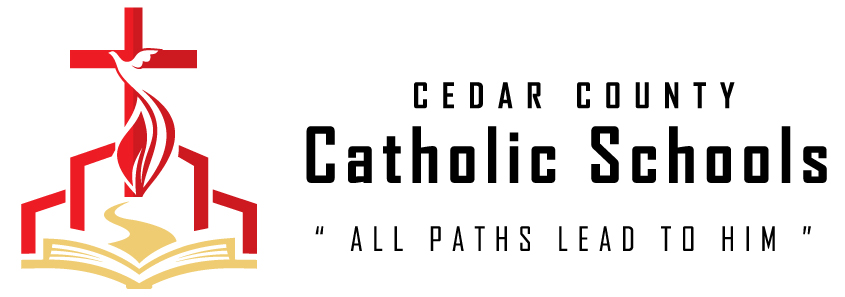History of Cedar Catholic High School
Over the years there have been many changes that have led to the Cedar Catholic Jr/Sr High School we know today. One part of the rich history of Cedar Catholic that has not changed is its core values: Faith and Family. In its century long history, Cedar Catholic has updated its facilities many times and continues to do so to this day. Cedar Catholic is also home to an impressive sports and fine arts tradition.
There have been many changes in Cedar Catholics history over the past 114 years. One of the biggest differences is the number of students that are in each class. In Cedar Catholic’s first year (1905) six students graduated. Over the next forty-five years, Cedar Catholic’s average class size increased to 54 in 1950. By the year 2000, the number had dropped back to 36. The current 2019 graduating class has 25 students.
In 1901 the Holy Trinity School was officially founded. In the year 1940 a new building’s construction started. In 1949, two more floors were added to the building. In 1964 the north wing of Holy Trinity was added. In 1964 ten parishes throughout Cedar county joined together, and Holy Trinity became Cedar Catholic High School. In 1995 the seventh and eighth grade classes were added. The school changed its name once again to Cedar Catholic Jr./ Sr. High. In the year 2015 Cedar Catholic finished its ongoing renovation of the school.
Cedar Catholic has had many athletic achievements throughout the years. In 1973 the boy’s basketball team made history, by being the first Cedar Catholic team to make it to state. Even more history followed in the years to come. The boy’s basketball team took home gold in both the 1980 and 1984 seasons. The Lady Trojans created some history themselves. The girl’s basketball team took home Class B gold in 1986. In 1989, the girl’s volleyball team followed in the basketball team’s footsteps when they won the State Championship in Class C-1. Cedar Golf has won state championships during the years 1995, 2005, and 2009. Gayle Dunn became the first track state champion in the history of Cedar Catholic, winning the 1984 girl’s Class B shot put. The most recent gold medal championship was the girl’s volleyball team in 2012.
Cedar Catholic has shown great diversity in their success with many state championships away from the field or court. The Trojans dominated State Speech and One Act in the early 1990’s. Cedar Catholic Speech Team won state during the years of 1990, 1991, 1992, and 1994.The One Act Team won the state championship in 1991 and was runner-up in 1988, 1989, 1992, and 1993.
SCHOOL
A unanimous vote in 1900 initiated the construction of Holy Trinity School. Just a year later, on January 9th, the school opened with 75 students who transferred from Hartington Public School. The following fall, a total of 155 students were enrolled from grades one through nine. For the next four years, an additional grade was added to the high school. In 1913, an east wing was added to accommodate the growing enrollment. Again, in 1940, the school building was over crowded.
A new school building (the current Cedar Catholic) was built south of the old building. The new building had only one floor. If necessary, a second and third floor would be built. The construction cost was approximately $27,000. The elementary was moved to this building, and the high school remained at the old building. In 1948, it was decided that the old high school building was unsafe. The class of 1949 was the last class to graduate from the old building.
Two more floors were added to the grade school to host the high school. The new addition, which cost $160,000, was debt free in September of the same year, due to the generosity of the parishioners and friends of Holy Trinity. The old high school was then destroyed.
In 1956, the enrollment of the grade school and high school was so large that another school building was necessary. The new school contained eight classrooms, a spacious gymnasium or Parish center, a cafeteria, and a well-equipped kitchen. This building, Holy Trinity Elementary School, it is still in use today.
During the years of 1960-1969, the Archbishop directed the consolidation of Holy Trinity School. High school students from Coleridge, Fordyce, Constance, St. James, Menominee, Bow Valley, St. Helena, Laurel, Wynot, and Hartington came together to create Cedar Catholic High School, with 238 students enrolled. An addition was added to the north side of the high school. The construction of this addition cost $400,000.
The Holy Trinity Grade School also needed an addition to their school building. In 1982, a music room, three classrooms, two athletic locker rooms, an athletic storage room and a kitchen storage room were constructed.
CHURCH
Holy Trinity Parish started with a tight-knit group of families that lent a hand to anyone in need. This community of faith has grown and seen many changes since its early days in 1884.
The town of Hartington was founded in the fall of 1883. The early settlers were mainly Catholic. Soon after founding the town, they decided to organize a parish and build a church. August Lubeley, one of these early pioneers, called a meeting of a few Catholic settlers to determine what could be done. Many of today’s Holy Trinity parishioners are descendants of the men who attended that meeting. The men at the first Parish Council meeting decided to build a small church in Hartington, the center of Cedar County. The church building was completed on June 12, 1884, and the first Holy Mass was celebrated that week. The first resident pastor, Rev. Henry Hoheisel, came in 1886. Holy Trinity Parish was officially incorporated into the Omaha Diocese on September 10, 1887.
The Holy Trinity Parish grew quickly, so a larger church was needed. In 1902, plans were made to build a $6,000 addition, but plans were changed for a new and larger Church. The price then increased from $6,000 to $15,000. A year later the first Eucharistic Feast was celebrated in the new, sturdier church. In 1913, a new brick parish house was built for $9,775.
On Thanksgiving Day of 1950, the church burned down. In order to celebrate Holy Mass, a metal building to house a Church was erected. This “church” was in use for 16 years. The “church” served its purpose until 1967, until the new church construction was completed. This church cost $270,000 to construct and the building is still in use today. Many renovations have taken place since 1967, such as new stain glass windows.
PRIEST
There have been a total of 14 priest to serve at Holy Trinity Parish
-
The first priest in Holy Trinity Parish was Fr. Henry Hoheisel (1886 to 1887).
-
Fr. Henry Schoof was the next to follow (1887-1888).
-
Fr. Henry Loecker was the priest at Holy Trinity in 1888-1904. He was also the first teacher to teach at Holy Trinity.
-
In 1904 Reverend George Glauber became pastor with the assistance of Fr. Bosheck.
-
In 1909 Fr. Bosheck became pastor until Fr. Ferdinand Schnuettgen was appointed. Fr. Schnuettgen passed away on a trip to Germany.
-
Msgr. Bernard Lordemann was appointed in 1930 and served for 30 years.
-
Fr. Raymond Auer became pastor in 1960 until 1969.
-
Msgr. Cyril J. Werner became pastor in 1969 and served until 1989. Msgr. Werner became one of the most influential pastors to serve Holy Trinity Parish. The new gymnasium is named after him.
-
Fr. Franklin Dvorak started his term at Holy Trinity parish in 1989 and served until 1995.
-
Fr. William Sanderson took over in 1995 until 2001.
-
Fr. Pietramale took over in 2001 and served until 2008.
-
Fr. Loseke became pastor in 2008 and served until 2016.
-
Fr. Korte started his term in 2016 and is currently still serving.





